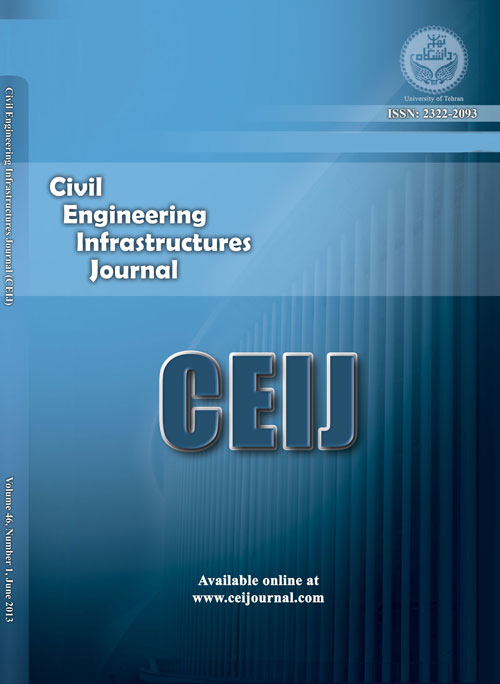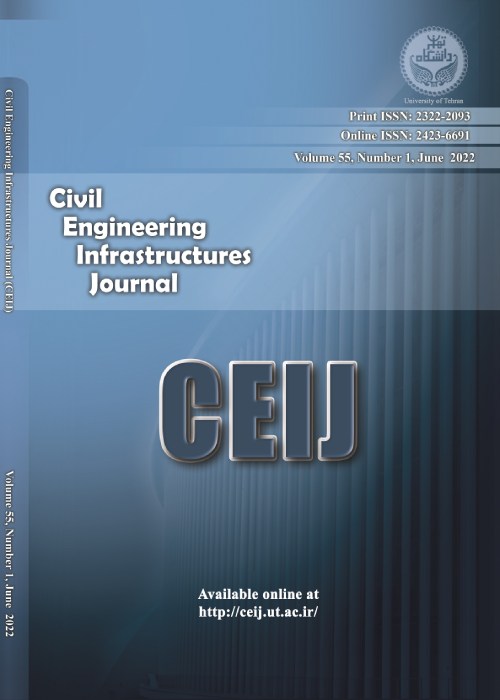فهرست مطالب

Civil Engineering Infrastructures Journal
Volume:48 Issue: 2, Dec 2015
- تاریخ انتشار: 1394/09/20
- تعداد عناوین: 11
-
-
Pages 217-234In this paper, an adaptive physics-based method is developed for solving wave motion problems in one dimension (i.e., wave propagation in strings, rods and beams). The solution of the problem includes two main parts. In the first part, after discretization of the domain, a physics-based method is developed considering the conservation of mass and the balance of momentum. In the second part, adaptive points are determined using the wavelet theory. This part is done employing the Deslauries-Dubuc (D-D) wavelets. By solving the problem in the first step, the domain of the problem is discretized by the same cells taking into consideration the load and characteristics of the structure. After the first trial solution, the D-D interpolation shows the lack and redundancy of points in the domain. These points will be added or eliminated for the next solution. This process may be repeated for obtaining an adaptive mesh for each step. Also, the smoothing spline fit is used to eliminate the noisy portion of the solution. Finally, the results of the proposed method are compared with the results available in the literature. The comparison shows excellent agreement between the obtained results and those already reported.Keywords: Adaptive solution, Deslauries, Dubuc wavelets, Multi, resolution analysis, Physics, based solution, Smoothing splines
-
Dynamic Analysis of Cylindrically Layered Structures Reinforced by Carbon Nanotube Using MLPG MethodPages 235-250This paper deals with the dynamic analysis of stress field in cylindrically layered structures reinforced by carbon nanotube (CLSRCN) subjected to mechanical shock loading. Application of meshless local integral equations based on meshless local Petrov-Galerkin (MLPG) method is developed for dynamic stress analysis in this article. Analysis is carried out in frequency domain by applying the Laplace transformation on governing equations and then the stresses are transferred to time domain, using Talbot inversion Laplace techniques. The mechanical properties of the nanocomposite are mathematically simulated using four types of carbon nanotube distributions in radial volume fraction forms. The propagation of stresses is indicated through radial direction for various grading patterns at different time instants. The effects of various grading patterns on stresses are specifically investigated. Numerical examples, presented in the accompanying section 4 of this paper, show that variation of * CN V has no significant effect on the amplitude of radial stresses. Examples illustrate that stress distributions in cylindrical layer structures made of a CNT type are more sensitive rather than other grading pattern types of CNTs. Results derived in this analysis are compared with FEM and previous published work and a good agreement is observed between them.Keywords: Carbon nanotube, Cylinder, Dynamic analysis, Layered, structures, Meshless local Petrov, Galerkin method
-
Pages 269-287This study attempts to answer the question of distinguishing appropriate intensity measure parameter for performance-based design or assessment, taking into account the efficiency aspect. The comprehensive comparative tables proposed in this paper could be an effective support in the decision making procedure for intensity measure selection, comprising most of the frequently utilized intensity measures for low-rise buildings with different fundamental periods. In addition, since some specific intensity measures are commonly applied in codes, the amounts of standard deviation computed in this study could be very beneficial in answering the question of being worthy to consider another intensity measure, to improve the certitude of structural responses, noting expansion in calculationefforts.Keywords: Efficiency, Interstory Drift Ratios (IDR), Engineering Demand Parameters (EDP), Intensity Measure (IM), Peak Floor Acceleration (PFA), Performance, Based Earthquake Engineering (PBEE)
-
Pages 289-301This research intends to develop a method based on the Artificial Neural Network (ANN) to predict permanent earthquake-induced deformation of the earth dams and embankments. For this purpose, data sets of observations from 152 published case histories on the performance of the earth dams and embankments, during the past earthquakes, was used. In order to predict earthquake-induced deformation of the earth dams and embankments a Multi-Layer Perceptron (MLP) analysis was used. A four-layer, feed-forward, back-propagation neural network, with a topology of 7-9-7-1 was found to be optimum. The results showed that an appropriately trained neural network could reliably predict permanent earthquake-induced deformation of the earth dams and embankments.Keywords: Artificial neural networks, Earth dam, Earth embankment, Earthquake, induced deformation
-
Pages 303-314The seismic performance of hybrid braces composed of steel and shape memory alloy (SMA) was investigated in this paper. Six types of hybrid braces were used, constituted by SMA content of 0, 20, 40, 60, 80, and 100%. A nonlinear dynamic analysis was performed under El Centro earthquake records, with the maximum acceleration of 0.6g and 0.9g. Our results showed that the seismic performance, i.e., the amount of energy absorption and residual strain, of steel–SMA hybrid braces depends on the SMA content. The optimal value of SMA content was 20%, as, at this concentration, a hybrid brace can be designed with good seismic performance at a justifiable fabrication cost.Keywords: Finite Element modeling, Hybrid brace, Nonlinear dynamic analysis, Seismic performance, Shape Memory Alloy (SMA)
-
Pages 315-322Steel corrosion of bars in concrete structures is a complex process which leads to the reduction of the cross-section bars and decreasing the resistance of the concrete and steel materials. In this study, reliability analysis of a reinforced concrete beam with corrosion defects under the distributed load was investigated using the enhanced Hasofer-Lind and Rackwitz-Fiessler (EHL-RF) method based on relaxed approach. Robustness of the EHL-RF algorithm was compared with the HL-RF using a complicated example. It was seen that the EHL-RF algorithm is more robust than the HL-RF method. Finally, the effects of corrosion time were investigated using the EHL-RF algorithm for a reinforced concrete beam based on flexural strength in the pitting and general corrosion. The model uncertainties were considered in the resistance and load terms of flexural strength limit state function. The results illustrated that increasing the corrosion time-period leads to increase in the failure probability of the corroded concrete beam.Keywords: Corrosion, Enhanced HL, RF method, Failure probability, Reliability analysis, Reinforced concrete
-
Pages 323-340In this paper, full scale load test of a horizontally curved steel box-girder bridge is carried out in order to detect structural defects, which reportedly result in unwanted vibrations in nearby buildings. The bridge is tested under the passage of six heavy vehicles at different speeds, so as to determine its static and dynamic responses. A total number of one hundred and two (102) sensors are used to measure the displacements, strains, and accelerations of different points of the bridge. It is observed that the bridge vibrates at a fundamental frequency of 2.6 Hz intensively and the first mode of vibration is torsional instead of flexural. The dominant frequency of vibration of the nearby buildings is computed to be approximately 2.5Hz using rational formulas. Thus, nearness of the fundamental frequency of the bridge to those of the adjacent buildings may be causing resonance phenomenon. However, in static load tests, low ranges of strain and displacement illustrated adequate structural capacity and appropriate safety under static loads. Numerical models are created using ANSYS and SAP2000 software products, so as to design the loading test and calibrate the finite element models. The connections of the transversal elements to the girders, transversal element spacing, and changes of the stiffness values of the slabs were found to be the most influential issues in the finite elements calibration process. Finally, considering the total damage of all members, the final health score of the bridge was evaluated as 89% indicating that the bridge is in a very good situation.Keywords: Dynamic, static loading tests, Frequencies of vibration, Horizontally curved bridges, Steel box, girder
-
Pages 341-362In this paper, the non-linear dynamic response of novel steel sandwich panel with hollow I-core subjected to blast loading was studied. Special emphasis is placed on the evaluation of midpoint displacements and energy dissipation of the models. Several parameters such as boundary conditions, strain rate, mesh dependency and asymmetrical loading are considered in this study. The material and geometric non-linearities are also considered in the numerical simulation. The results obtained are compared with available experimental data to verify the developed FE model. Modeling techniques are described in detail. According to the results, sandwich panels with hollow I-core allowed more plastic deformation and energy dissipation and less midpoint displacement than conventional I-core sandwich panels and also equivalent solid plate with the same weight and material.Keywords: Blast, Dynamic non, linear analysis, Energy dissipation, Sandwich panel
-
Optimal Control via Integrating the Dynamics of Magnetorheological Dampers and StructuresPages 363-375Magnetorheological (MR) dampers have the advantage of being tuned by low voltages. This has attracted many researchers to develop semi-active control of structures in theory and practice. Most of the control strategies first obtain the desired forces of dampers without taking their dynamics into consideration and then determine the input voltages according to those forces. As a result, these strategies may face situations where the desired forces cannot be produced by the dampers. In this article, by integrating the equations of the dynamics of MR dampers and the structural motion, and solving them in one set, a more concise semi-active optimal control strategy is presented, so as to bypass the aforementioned drawback. Next, a strong database that can be utilized to form a controller for more realistic implementations is produced. As an illustrative example, the optimal voltages of the dampers of a six-storey shear building are obtained under the scaled El-Centro earthquake and used to train a set of integrated analysis-adaptive neuro-fuzzy inference systems (ANFISs) as a controller. Results show that the overall performance of the proposed strategy is higher than most of the other conventional methods.Keywords: ANFIS, Earthquake excitation, MR damper, Optimal control, Semi, active control
-
Pages 377-390Dynamic response of underground structures has always been a topic of concern for designers and researchers. The behavior of these complicated systems under blast loading is affected by various factors and parametric studies are required to investigate their significance. The importance of soil density around the underground structure through which, the waves of explosion of a penetrator bomb is transferred, has been studied in this paper by using finite difference method (FDM). According to the results, soils with higher degrees of compactioncan absorb explosion energy more significantly. Therefore, the displacements and stresses of underground structure lining in denser soils are moderately lower. Thebending moment of the lining should be given attention, as regards being a critical design parameter.Keywords: Bomb, Finite difference method, Passive defense, Underground structure
-
Pages 391-398The aim of this study was to estimate suspended sediment by the ANN model, DT with CART algorithm and different types of SRC, in ten stations from the Lorestan Province of Iran. The results showed that the accuracy of ANN with Levenberg-Marquardt back propagation algorithm is more than the two other models, especially in high discharges. Comparison of different intervals in models showed that running models with monthly data,resulted in smaller error and better estimated results. Moreover, results showed that using Minimum Variance Unbiased Estimator (MVUE) bias correction factor modified the SRC results, especially in monthly time steps in almost all stations. Hence, it can be said that if because of advantages such as simplicity, SRC models are preferred, it is better that MSRC (modified sediment rating curve) is used in monthly period.Keywords: Artificial Neural Network, CART algorithm, Decision Tree, Levenberg, Marquardt algorithm, Sediment Rating Curve


